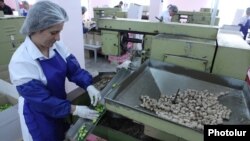In a further sign of slower-than-expected economic growth, industrial production in Armenia did not increase in the first half of this year, according to government statistics.
Detailed figures released by the National Statistical Service (NSS) show that industrial output was flat at almost 580 billion drams ($1.4 billion) in that period. Downturns in mining and power generation appear to have been instrumental in the zero growth.
In particular, the NSS registered a 9 percent drop in the first-half production of metal ores and ore concentrates worth a total of 92.5 billion drams. This was apparently due to a more than 10 percent fall in international prices for copper, a key Armenian export, in January-June 2014. The copper prices rallied in July and this month but are still well below the January level.
That did not prevent the metallurgical sector, closely linked to mining, from expanding by almost 10 percent to 82 billion drams. Output in Armenia’s single largest manufacturing sector, food processing, was up by 2.3 percent at 135.5 billion drams. By contrast, electricity production in the country shrunk by 3.4 percent year on year to 85 billion drams, according to the NSS.
The Armenian Ministry of Economy downplayed on Tuesday the worse-than-expected industrial data. A senior ministry official, Armen Yeganian, said industrial production has been picking up in recent months after contracting in the first half of this year.
“According to our forecasts, there will be some growth and industrial output will get back on track in the second half,” Yeganian told RFE/RL’s Armenian service (Azatutyun.am). The government specifically anticipates upswings in the mining and food-processing sectors, he said.
Manufacturing has been a key driving force of economic growth in Armenia since the 2008-2009 global financial crisis. The Armenian economy had expanded at double-digit rates until then thanks to a construction boom.
The authorities in Yerevan have repeatedly promised government support for the industry, saying that its steady development is vital for diversifying the economy and thus making it less vulnerable to external shocks. Hayk Gevorgian, an economics writer for the pro-opposition daily “Haykakan Zhamanak,” said that the governments of both Prime Minister Hovik Abrahamian and his predecessor Tigran Sarkisian have failed to deliver on those pledges. Gevorgian pointed to lingering problems with the rule of law and fair competition among businesses.
Abrahamian’s cabinet last month lowered its economic growth forecast for 2014 to 4 percent from 5 percent. But it said Armenian growth will accelerate to 5 percent next year and 5.3 percent in 2016.




